Investor Report: Financial Analysis of Macquarie Group (2018-2019)
VerifiedAdded on 2022/10/19
|5
|1428
|284
Report
AI Summary
This report provides a detailed financial analysis of Macquarie Group, focusing on key performance indicators derived from its 2018 and 2019 annual reports. The analysis includes an examination of profitability ratios (gross profit margin, net profit margin, return on equity), efficiency ratios (return on total assets), liquidity ratios (current ratio), and capital structure ratios (debt-to-equity ratio). The report interprets the trends in these ratios, along with an analysis of dividend per share and price-earnings ratio over a five-year period. It also incorporates credit ratings and outlooks from S&P Global to assess the company's credit risk profile. The report highlights Macquarie Group's strengths, such as its impressive profitability and sufficient capital, while also addressing potential threats like Brexit uncertainties and rising regulatory scrutiny. The conclusion offers investment recommendations, suggesting areas for improvement like reducing operating costs and optimizing the capital structure to enhance financial health and shareholder value. The report provides an informed perspective for potential investors considering Macquarie Group.
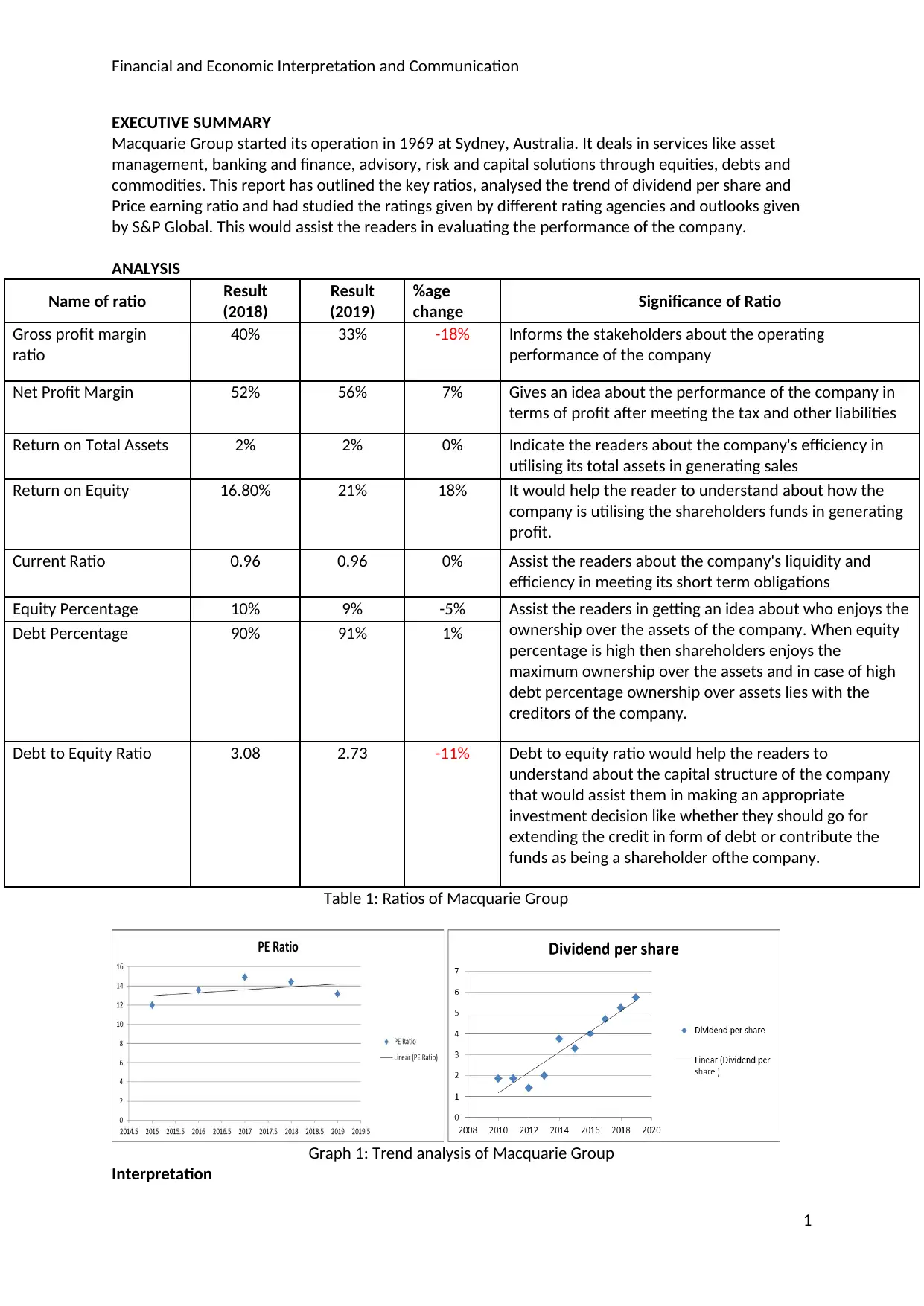
Financial and Economic Interpretation and Communication
EXECUTIVE SUMMARY
Macquarie Group started its operation in 1969 at Sydney, Australia. It deals in services like asset
management, banking and finance, advisory, risk and capital solutions through equities, debts and
commodities. This report has outlined the key ratios, analysed the trend of dividend per share and
Price earning ratio and had studied the ratings given by different rating agencies and outlooks given
by S&P Global. This would assist the readers in evaluating the performance of the company.
ANALYSIS
Name of ratio Result
(2018)
Result
(2019)
%age
change Significance of Ratio
Gross profit margin
ratio
40% 33% -18% Informs the stakeholders about the operating
performance of the company
Net Profit Margin 52% 56% 7% Gives an idea about the performance of the company in
terms of profit after meeting the tax and other liabilities
Return on Total Assets 2% 2% 0% Indicate the readers about the company's efficiency in
utilising its total assets in generating sales
Return on Equity 16.80% 21% 18% It would help the reader to understand about how the
company is utilising the shareholders funds in generating
profit.
Current Ratio 0.96 0.96 0% Assist the readers about the company's liquidity and
efficiency in meeting its short term obligations
Equity Percentage 10% 9% -5% Assist the readers in getting an idea about who enjoys the
ownership over the assets of the company. When equity
percentage is high then shareholders enjoys the
maximum ownership over the assets and in case of high
debt percentage ownership over assets lies with the
creditors of the company.
Debt Percentage 90% 91% 1%
Debt to Equity Ratio 3.08 2.73 -11% Debt to equity ratio would help the readers to
understand about the capital structure of the company
that would assist them in making an appropriate
investment decision like whether they should go for
extending the credit in form of debt or contribute the
funds as being a shareholder ofthe company.
Table 1: Ratios of Macquarie Group
Graph 1: Trend analysis of Macquarie Group
Interpretation
1
EXECUTIVE SUMMARY
Macquarie Group started its operation in 1969 at Sydney, Australia. It deals in services like asset
management, banking and finance, advisory, risk and capital solutions through equities, debts and
commodities. This report has outlined the key ratios, analysed the trend of dividend per share and
Price earning ratio and had studied the ratings given by different rating agencies and outlooks given
by S&P Global. This would assist the readers in evaluating the performance of the company.
ANALYSIS
Name of ratio Result
(2018)
Result
(2019)
%age
change Significance of Ratio
Gross profit margin
ratio
40% 33% -18% Informs the stakeholders about the operating
performance of the company
Net Profit Margin 52% 56% 7% Gives an idea about the performance of the company in
terms of profit after meeting the tax and other liabilities
Return on Total Assets 2% 2% 0% Indicate the readers about the company's efficiency in
utilising its total assets in generating sales
Return on Equity 16.80% 21% 18% It would help the reader to understand about how the
company is utilising the shareholders funds in generating
profit.
Current Ratio 0.96 0.96 0% Assist the readers about the company's liquidity and
efficiency in meeting its short term obligations
Equity Percentage 10% 9% -5% Assist the readers in getting an idea about who enjoys the
ownership over the assets of the company. When equity
percentage is high then shareholders enjoys the
maximum ownership over the assets and in case of high
debt percentage ownership over assets lies with the
creditors of the company.
Debt Percentage 90% 91% 1%
Debt to Equity Ratio 3.08 2.73 -11% Debt to equity ratio would help the readers to
understand about the capital structure of the company
that would assist them in making an appropriate
investment decision like whether they should go for
extending the credit in form of debt or contribute the
funds as being a shareholder ofthe company.
Table 1: Ratios of Macquarie Group
Graph 1: Trend analysis of Macquarie Group
Interpretation
1
Paraphrase This Document
Need a fresh take? Get an instant paraphrase of this document with our AI Paraphraser
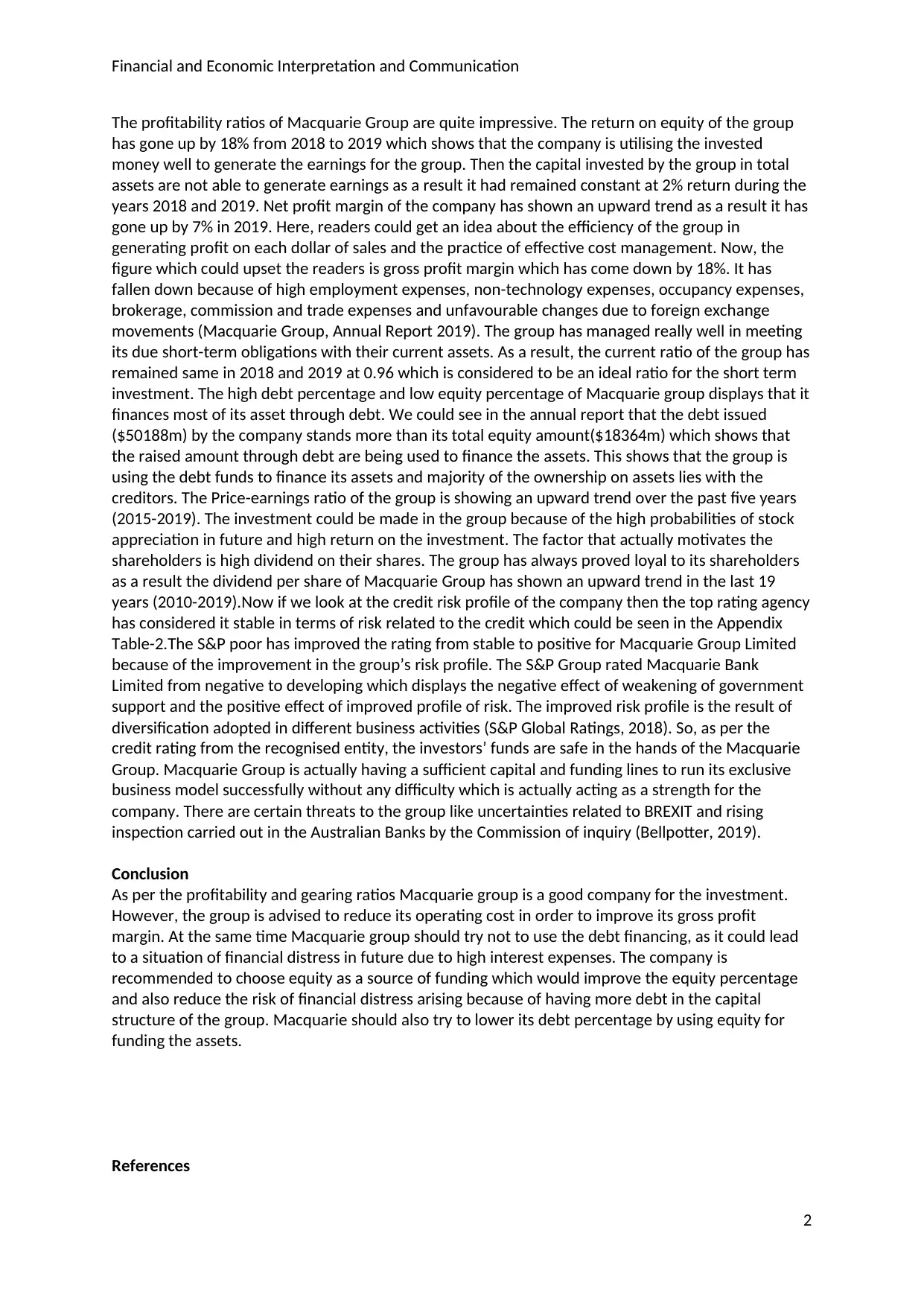
Financial and Economic Interpretation and Communication
The profitability ratios of Macquarie Group are quite impressive. The return on equity of the group
has gone up by 18% from 2018 to 2019 which shows that the company is utilising the invested
money well to generate the earnings for the group. Then the capital invested by the group in total
assets are not able to generate earnings as a result it had remained constant at 2% return during the
years 2018 and 2019. Net profit margin of the company has shown an upward trend as a result it has
gone up by 7% in 2019. Here, readers could get an idea about the efficiency of the group in
generating profit on each dollar of sales and the practice of effective cost management. Now, the
figure which could upset the readers is gross profit margin which has come down by 18%. It has
fallen down because of high employment expenses, non-technology expenses, occupancy expenses,
brokerage, commission and trade expenses and unfavourable changes due to foreign exchange
movements (Macquarie Group, Annual Report 2019). The group has managed really well in meeting
its due short-term obligations with their current assets. As a result, the current ratio of the group has
remained same in 2018 and 2019 at 0.96 which is considered to be an ideal ratio for the short term
investment. The high debt percentage and low equity percentage of Macquarie group displays that it
finances most of its asset through debt. We could see in the annual report that the debt issued
($50188m) by the company stands more than its total equity amount($18364m) which shows that
the raised amount through debt are being used to finance the assets. This shows that the group is
using the debt funds to finance its assets and majority of the ownership on assets lies with the
creditors. The Price-earnings ratio of the group is showing an upward trend over the past five years
(2015-2019). The investment could be made in the group because of the high probabilities of stock
appreciation in future and high return on the investment. The factor that actually motivates the
shareholders is high dividend on their shares. The group has always proved loyal to its shareholders
as a result the dividend per share of Macquarie Group has shown an upward trend in the last 19
years (2010-2019).Now if we look at the credit risk profile of the company then the top rating agency
has considered it stable in terms of risk related to the credit which could be seen in the Appendix
Table-2.The S&P poor has improved the rating from stable to positive for Macquarie Group Limited
because of the improvement in the group’s risk profile. The S&P Group rated Macquarie Bank
Limited from negative to developing which displays the negative effect of weakening of government
support and the positive effect of improved profile of risk. The improved risk profile is the result of
diversification adopted in different business activities (S&P Global Ratings, 2018). So, as per the
credit rating from the recognised entity, the investors’ funds are safe in the hands of the Macquarie
Group. Macquarie Group is actually having a sufficient capital and funding lines to run its exclusive
business model successfully without any difficulty which is actually acting as a strength for the
company. There are certain threats to the group like uncertainties related to BREXIT and rising
inspection carried out in the Australian Banks by the Commission of inquiry (Bellpotter, 2019).
Conclusion
As per the profitability and gearing ratios Macquarie group is a good company for the investment.
However, the group is advised to reduce its operating cost in order to improve its gross profit
margin. At the same time Macquarie group should try not to use the debt financing, as it could lead
to a situation of financial distress in future due to high interest expenses. The company is
recommended to choose equity as a source of funding which would improve the equity percentage
and also reduce the risk of financial distress arising because of having more debt in the capital
structure of the group. Macquarie should also try to lower its debt percentage by using equity for
funding the assets.
References
2
The profitability ratios of Macquarie Group are quite impressive. The return on equity of the group
has gone up by 18% from 2018 to 2019 which shows that the company is utilising the invested
money well to generate the earnings for the group. Then the capital invested by the group in total
assets are not able to generate earnings as a result it had remained constant at 2% return during the
years 2018 and 2019. Net profit margin of the company has shown an upward trend as a result it has
gone up by 7% in 2019. Here, readers could get an idea about the efficiency of the group in
generating profit on each dollar of sales and the practice of effective cost management. Now, the
figure which could upset the readers is gross profit margin which has come down by 18%. It has
fallen down because of high employment expenses, non-technology expenses, occupancy expenses,
brokerage, commission and trade expenses and unfavourable changes due to foreign exchange
movements (Macquarie Group, Annual Report 2019). The group has managed really well in meeting
its due short-term obligations with their current assets. As a result, the current ratio of the group has
remained same in 2018 and 2019 at 0.96 which is considered to be an ideal ratio for the short term
investment. The high debt percentage and low equity percentage of Macquarie group displays that it
finances most of its asset through debt. We could see in the annual report that the debt issued
($50188m) by the company stands more than its total equity amount($18364m) which shows that
the raised amount through debt are being used to finance the assets. This shows that the group is
using the debt funds to finance its assets and majority of the ownership on assets lies with the
creditors. The Price-earnings ratio of the group is showing an upward trend over the past five years
(2015-2019). The investment could be made in the group because of the high probabilities of stock
appreciation in future and high return on the investment. The factor that actually motivates the
shareholders is high dividend on their shares. The group has always proved loyal to its shareholders
as a result the dividend per share of Macquarie Group has shown an upward trend in the last 19
years (2010-2019).Now if we look at the credit risk profile of the company then the top rating agency
has considered it stable in terms of risk related to the credit which could be seen in the Appendix
Table-2.The S&P poor has improved the rating from stable to positive for Macquarie Group Limited
because of the improvement in the group’s risk profile. The S&P Group rated Macquarie Bank
Limited from negative to developing which displays the negative effect of weakening of government
support and the positive effect of improved profile of risk. The improved risk profile is the result of
diversification adopted in different business activities (S&P Global Ratings, 2018). So, as per the
credit rating from the recognised entity, the investors’ funds are safe in the hands of the Macquarie
Group. Macquarie Group is actually having a sufficient capital and funding lines to run its exclusive
business model successfully without any difficulty which is actually acting as a strength for the
company. There are certain threats to the group like uncertainties related to BREXIT and rising
inspection carried out in the Australian Banks by the Commission of inquiry (Bellpotter, 2019).
Conclusion
As per the profitability and gearing ratios Macquarie group is a good company for the investment.
However, the group is advised to reduce its operating cost in order to improve its gross profit
margin. At the same time Macquarie group should try not to use the debt financing, as it could lead
to a situation of financial distress in future due to high interest expenses. The company is
recommended to choose equity as a source of funding which would improve the equity percentage
and also reduce the risk of financial distress arising because of having more debt in the capital
structure of the group. Macquarie should also try to lower its debt percentage by using equity for
funding the assets.
References
2
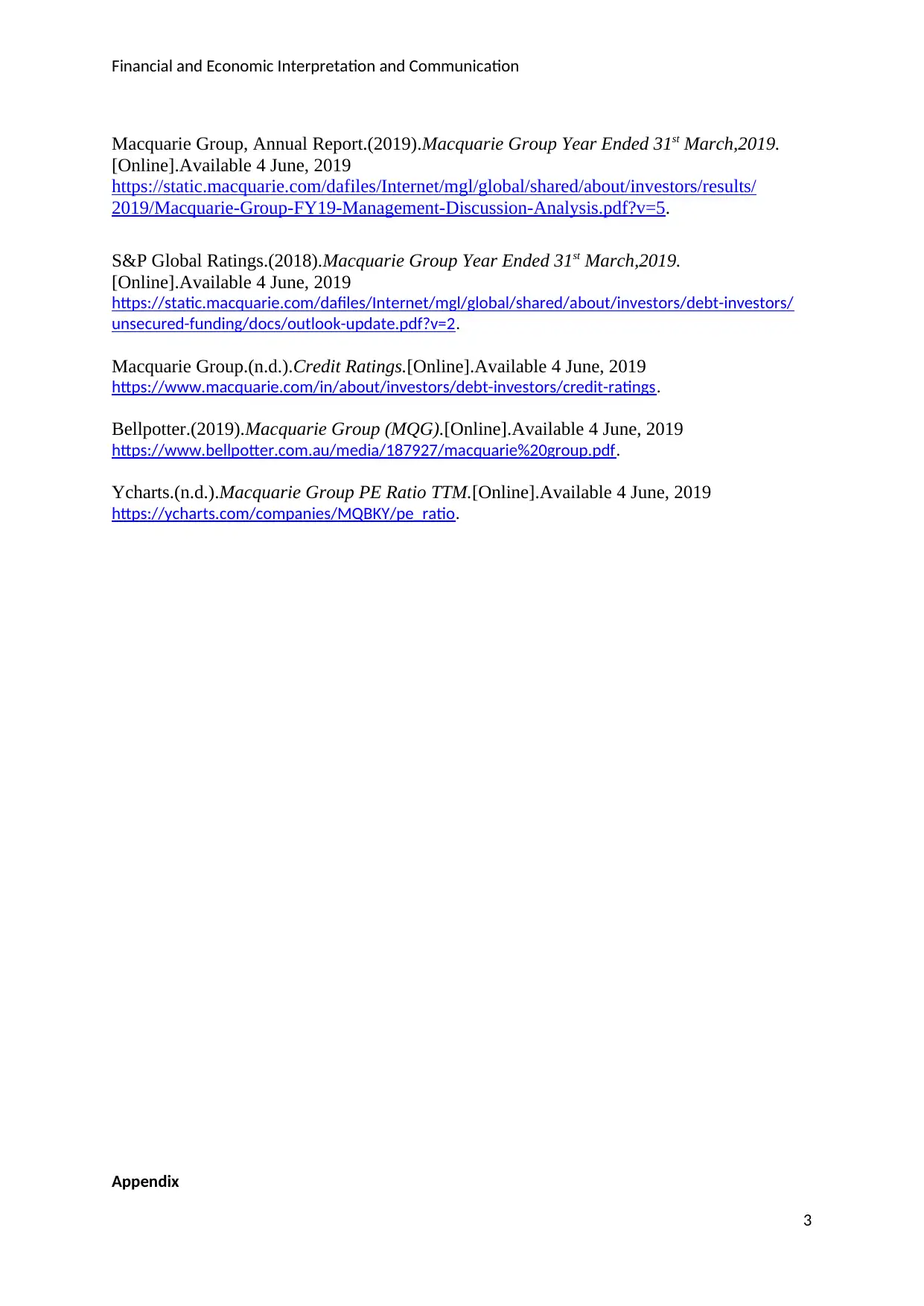
Financial and Economic Interpretation and Communication
Macquarie Group, Annual Report.(2019).Macquarie Group Year Ended 31st March,2019.
[Online].Available 4 June, 2019
https://static.macquarie.com/dafiles/Internet/mgl/global/shared/about/investors/results/
2019/Macquarie-Group-FY19-Management-Discussion-Analysis.pdf?v=5.
S&P Global Ratings.(2018).Macquarie Group Year Ended 31st March,2019.
[Online].Available 4 June, 2019
https://static.macquarie.com/dafiles/Internet/mgl/global/shared/about/investors/debt-investors/
unsecured-funding/docs/outlook-update.pdf?v=2.
Macquarie Group.(n.d.).Credit Ratings.[Online].Available 4 June, 2019
https://www.macquarie.com/in/about/investors/debt-investors/credit-ratings.
Bellpotter.(2019).Macquarie Group (MQG).[Online].Available 4 June, 2019
https://www.bellpotter.com.au/media/187927/macquarie%20group.pdf.
Ycharts.(n.d.).Macquarie Group PE Ratio TTM.[Online].Available 4 June, 2019
https://ycharts.com/companies/MQBKY/pe_ratio.
Appendix
3
Macquarie Group, Annual Report.(2019).Macquarie Group Year Ended 31st March,2019.
[Online].Available 4 June, 2019
https://static.macquarie.com/dafiles/Internet/mgl/global/shared/about/investors/results/
2019/Macquarie-Group-FY19-Management-Discussion-Analysis.pdf?v=5.
S&P Global Ratings.(2018).Macquarie Group Year Ended 31st March,2019.
[Online].Available 4 June, 2019
https://static.macquarie.com/dafiles/Internet/mgl/global/shared/about/investors/debt-investors/
unsecured-funding/docs/outlook-update.pdf?v=2.
Macquarie Group.(n.d.).Credit Ratings.[Online].Available 4 June, 2019
https://www.macquarie.com/in/about/investors/debt-investors/credit-ratings.
Bellpotter.(2019).Macquarie Group (MQG).[Online].Available 4 June, 2019
https://www.bellpotter.com.au/media/187927/macquarie%20group.pdf.
Ycharts.(n.d.).Macquarie Group PE Ratio TTM.[Online].Available 4 June, 2019
https://ycharts.com/companies/MQBKY/pe_ratio.
Appendix
3
⊘ This is a preview!⊘
Do you want full access?
Subscribe today to unlock all pages.

Trusted by 1+ million students worldwide
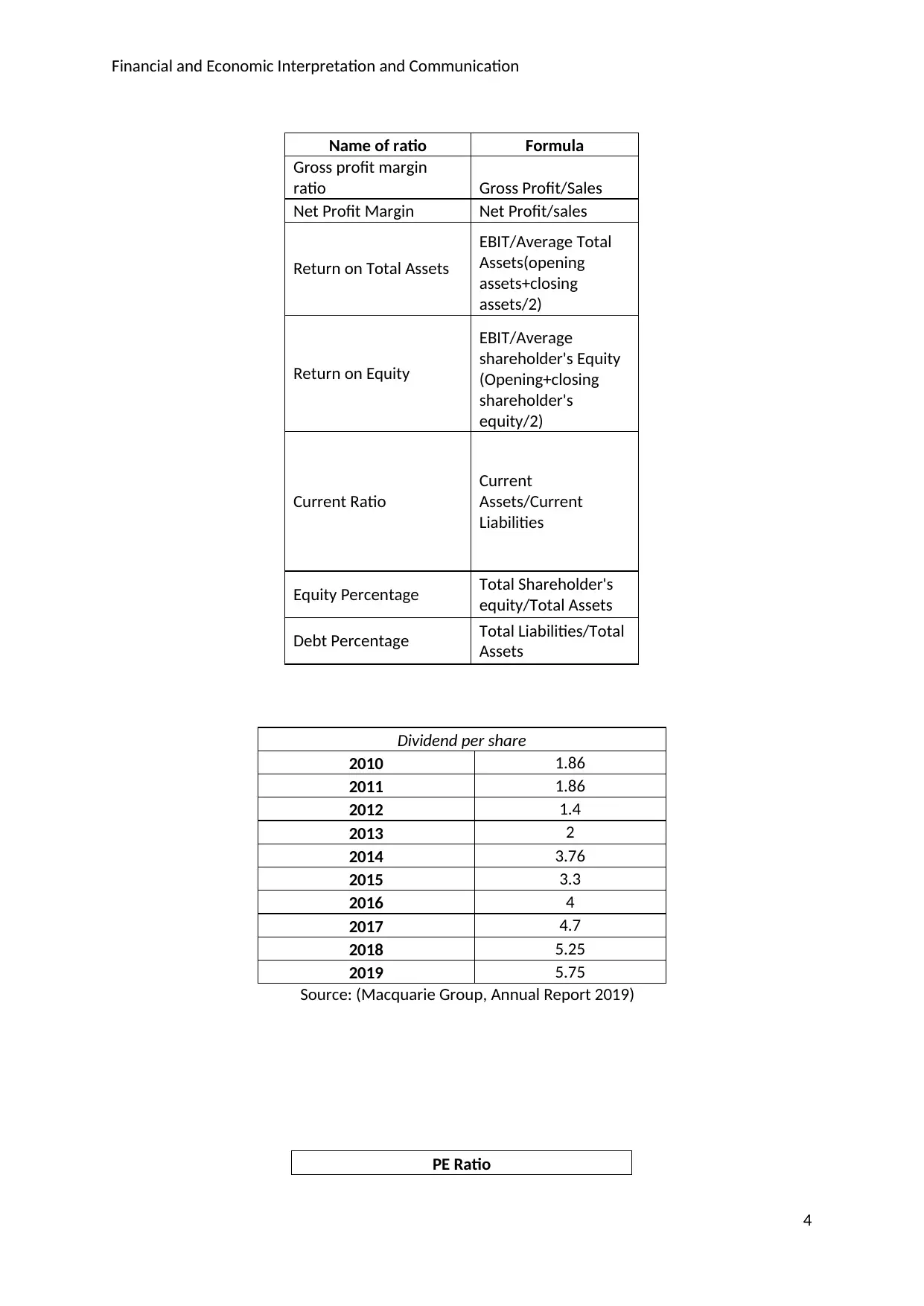
Financial and Economic Interpretation and Communication
Name of ratio Formula
Gross profit margin
ratio Gross Profit/Sales
Net Profit Margin Net Profit/sales
Return on Total Assets
EBIT/Average Total
Assets(opening
assets+closing
assets/2)
Return on Equity
EBIT/Average
shareholder's Equity
(Opening+closing
shareholder's
equity/2)
Current Ratio
Current
Assets/Current
Liabilities
Equity Percentage Total Shareholder's
equity/Total Assets
Debt Percentage Total Liabilities/Total
Assets
Dividend per share
2010 1.86
2011 1.86
2012 1.4
2013 2
2014 3.76
2015 3.3
2016 4
2017 4.7
2018 5.25
2019 5.75
Source: (Macquarie Group, Annual Report 2019)
PE Ratio
4
Name of ratio Formula
Gross profit margin
ratio Gross Profit/Sales
Net Profit Margin Net Profit/sales
Return on Total Assets
EBIT/Average Total
Assets(opening
assets+closing
assets/2)
Return on Equity
EBIT/Average
shareholder's Equity
(Opening+closing
shareholder's
equity/2)
Current Ratio
Current
Assets/Current
Liabilities
Equity Percentage Total Shareholder's
equity/Total Assets
Debt Percentage Total Liabilities/Total
Assets
Dividend per share
2010 1.86
2011 1.86
2012 1.4
2013 2
2014 3.76
2015 3.3
2016 4
2017 4.7
2018 5.25
2019 5.75
Source: (Macquarie Group, Annual Report 2019)
PE Ratio
4
Paraphrase This Document
Need a fresh take? Get an instant paraphrase of this document with our AI Paraphraser
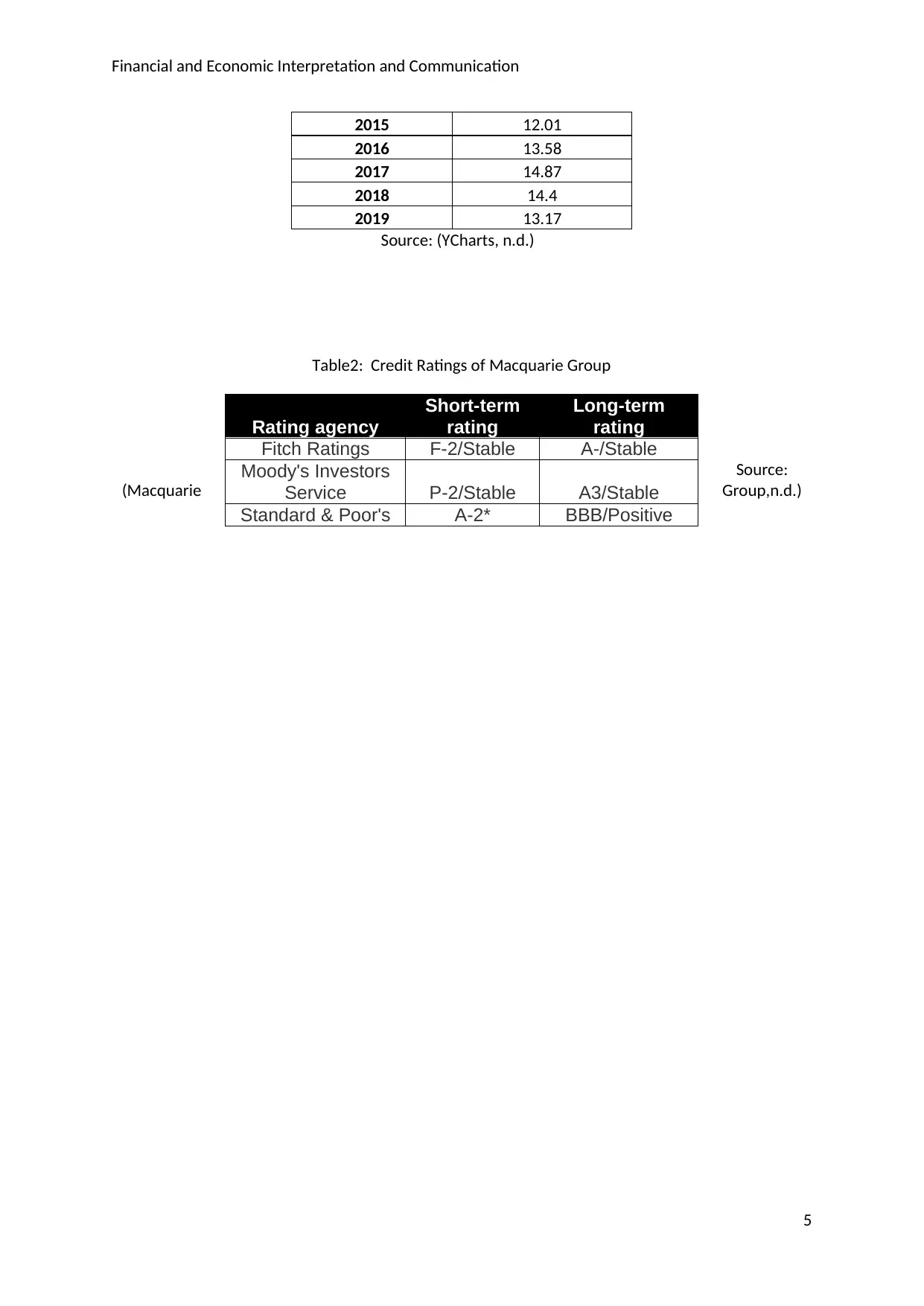
Financial and Economic Interpretation and Communication
2015 12.01
2016 13.58
2017 14.87
2018 14.4
2019 13.17
Source: (YCharts, n.d.)
Table2: Credit Ratings of Macquarie Group
Source:
(Macquarie Group,n.d.)
5
Rating agency
Short-term
rating
Long-term
rating
Fitch Ratings F-2/Stable A-/Stable
Moody's Investors
Service P-2/Stable A3/Stable
Standard & Poor's A-2* BBB/Positive
2015 12.01
2016 13.58
2017 14.87
2018 14.4
2019 13.17
Source: (YCharts, n.d.)
Table2: Credit Ratings of Macquarie Group
Source:
(Macquarie Group,n.d.)
5
Rating agency
Short-term
rating
Long-term
rating
Fitch Ratings F-2/Stable A-/Stable
Moody's Investors
Service P-2/Stable A3/Stable
Standard & Poor's A-2* BBB/Positive
1 out of 5
Related Documents
Your All-in-One AI-Powered Toolkit for Academic Success.
+13062052269
info@desklib.com
Available 24*7 on WhatsApp / Email
![[object Object]](/_next/static/media/star-bottom.7253800d.svg)
Unlock your academic potential
Copyright © 2020–2025 A2Z Services. All Rights Reserved. Developed and managed by ZUCOL.




